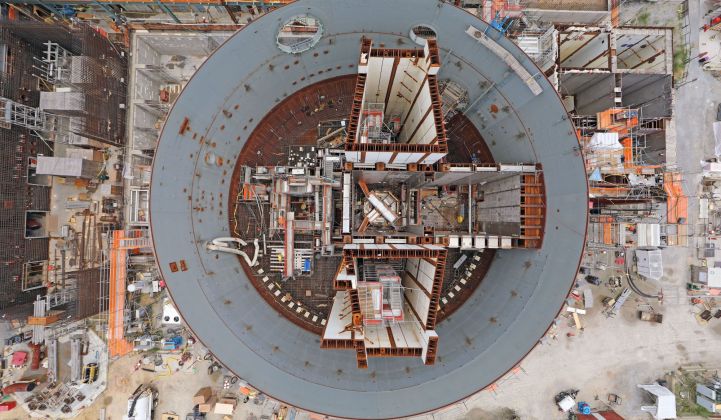A Massachusetts Institute of Technology team has shed light on a key challenge for the nuclear industry: the rising cost of new plants. And the answer provides support to those who believe small modular reactors ultimately may be the best route to cost reduction.
It turns out that the main reason for spiraling nuclear plant construction bills is soft costs, the indirect expenses related to activities such as engineering design, purchasing, planning, scheduling and — ironically — estimating and cost control.
These indirect expenses accounted for 72 percent of the increase seen in reactor construction costs between 1976 and 1987, a period in which the amount of money needed for containment buildings rose by almost 118 percent.
This period was studied because it has reliable data on all the components of a Westinghouse four-loop nuclear plant. But the researchers found similar trends across other reactor designs and timeframes, right up to 2017.
Containment building costs more than doubled from 1976 to 2017, for example. This was “due only in part to safety regulations,” noted the authors.
The research is sober reading for those who contend that the more times a reactor model is built, the less it will cost. This is the logic behind incentives for new nuclear in the U.K., where developers are expected to meet significantly lower strike prices for energy from additional reactors.
According to the MIT research, however, in three out of four U.S. reactor designs, the first to be built was also the cheapest. Only General Electric's BWR-4 boiling water reactor managed to get cheaper after the first plant. But 14 out of 18 of the plants studied ended up being more expensive.
How soft costs are creating a headache for new nuclear plant development
“Counter to expectation, nth-of-a-kind plants have been more expensive than first-of-a-kind plants,” concludes the study, published in Joule.
This mismatch between expectation and reality has dogged the nuclear industry in several markets.
Labor productivity in recent plants, for example, is up to 13 times lower than industry expectations, which goes a long way to explaining why the price tag for the Vogtle project in Georgia has more than doubled, rising to around $25 billion.
Vogtle also offers an insight into why productivity is so low. The project, much like Flamanville in France and Olkiluoto 3 in Finland, has been hampered by delays. And each setback adds to the total cost as workers stand idle and managers tinker with revised schedules.
Such delays are typical of large projects where the design is subject to change as construction progresses. And that is a factor that could favor one area where the nuclear industry really is betting on getting costs down through nth-of-a-kind construction: small modular reactors (SMRs).
One way to beat the soft-cost challenge is to streamline reactor design with advanced materials and components that don’t require as much on-site construction, Jessika Trancik, associate professor of energy studies at MIT’s Institute for Data, Systems and Society, said in an interview.
SMRs could avoid the soft-cost challenge — but is time running out?
“That’s where we start to get into the potential for more modular reactor design,” she said. “The idea is to bring more of the process into a manufacturing plant and off a construction site. Another design change is to pursue further automation of the construction process.”
SMRs have their own challenges, most notably the decade-long timescales still needed to move them toward commercial viability, and the cost uncertainties involved with building first-of-a-kind designs. At present, leading SMR contenders include Russia, which has built a floating SMR that is now in operation, and China, which is building SMR units today, albeit with less advanced designs.
European and North American SMRs are further out. Portland, Ore.-based NuScale Power, one of the earliest SMR companies, has spent more than a decade seeking approval from federal regulators, and its first proposed project in Idaho isn’t set to come online until the end of the decade. SMR designs from the Bill Gates-backed TerraPower and X-energy recently received financial support from the U.S. Department of Energy for the goal of building their first working units in the next seven years.
In the U.K., an SMR consortium led by Rolls-Royce has seen its planned 2030 commercial operations data threatened by the potential loss of government funding.
Even so, Jonathan Cobb, senior communication manager at the World Nuclear Association, said in an email that the research “specifically highlights that the construction of smaller and modular components, off-site in factories, would be one way to avoid cost escalations.”
The findings of the research could also be applied to large-scale plants, he said.
“In the U.K., there are expected to be significant cost reductions with the proposed Sizewell C plant because great efforts are being made to duplicate as much of the plant currently under construction at Hinkley Point C, rather than change that design,” he commented.
“Construction would also have taken place having gained approval for the [European pressurized reactor] design through the U.K.'s [generic design assessment] process.”
It all bodes well for nuclear. The question is whether the nuclear industry will get a chance to apply MIT’s findings in North American and European markets that have already tired of expensive plant construction sagas.




